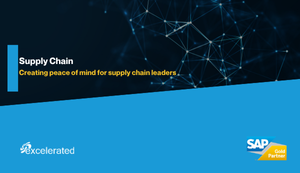/Project Management/Mobile
Applications on mobile devices are simple, user friendly, and accessible. Deploying a mobile platform for your company, however, is anything but simple. The role of an innovative IT management team is vital to help businesses build a strategy to meet these goals. To make mobility an accessible option for your business, you need to build a business case and have the right technical architecture and skilled resources to design, develop, and deploy the applications. Explore these ideas to get you started on your own mobility journey.
Key Concept
For most large corporations, embarking on a mobile strategy will likely begin with deploying a single Mobile Enterprise Application Platform (MEAP) — a combination of tools that enables development and deployment of applications across multiple mobile platforms and secures corporate data by controlling mobile devices. The MEAP may be considered a technical prerequisite for embarking on your mobile journey, however, before you even have the technology in-house, there are steps you can and should take to build your mobile strategy.
A certain kind of nimbleness is required to successfully develop and grow a business in today’s world. Human resources departments – once simply the keepers of records and masters of recruiting and retention transactions – are becoming strategic partners with companies in cultivating an environment that facilitates a new, more agile workforce. One of the many ways technologists can help HR to be successful with these endeavors is through building and driving a mobile strategy for HR.
Build a Business Case
Why does HR need to worry about mobile devices? There are at least three concrete reasons that immediately come to mind:
- The workforce
- Technology
- Society
The Workforce
When you think of your employees in today’s world, one fact becomes apparent: nearly every employee owns at least one mobile device. Accessibility and increased use of digital devices are parts of the equation. However, demand alone is not a driver. The first thing you have to do is understand your workforce — where they are in the world, where they do their work, what they need to know to do their jobs, and what tools they need to have to do their jobs effectively.
This is where building the case for mobility begins, especially for global companies. For example, consider that in some parts of Asia there is better 3G connectivity than Internet connectivity. If you have workers on a plant or shop floor who need current information to do their jobs (e.g., access to safety or product information, how-to guides, or scheduling information), a mobile device that is readily available may suit their needs better than leaving the shop floor to go to a PC. If you have a sales force on the road, think about how important it is for those salespeople to have immediate access to current product information to do their jobs effectively.
Technology
As important as who makes up your workforce is what technology they are using — now and in the future — to stay productive and efficient. Today we are undergoing a small-screen revolution. Mobile phones are now the PCs of choice for a new generation of workers. Demographics are shifting as baby boomers retire. Human resources departments need to be cognizant of how this new group of workers uses new technologies on the job because it is these workers who will soon comprise the majority of the workforce.
Another issue is how to transfer knowledge from the old generation of workers to the new. The new workforce needs to be trained, and trained quickly, to fill the gap. Moreover, employees entering the workforce today learn differently. The Internet has forced a subtle shift in how we acquire knowledge. Today’s workers learn more from each other and from their own research using the wealth of available online information than through formal classroom training. Think of Wikipedia, which has grown immensely by allowing users to create, add, and modify information themselves. Mobile devices enable connectivity with each other in order to collaborate together for results. Mobile devices can also be used to deliver just-in-time information required for success. Increasingly, these new workers will rely on their mobile devices to do their jobs successfully.
Society
Fact: The mobile phone is an essential social tool. While society has frowned on the use of texting to keep in touch and the use of ever-present mobile devices at the dinner table and in movie theaters, the fact of the matter is that cell phones have become a primary source of communication. Cell phones enable users to keep in touch across miles and generations, and more often than not, keeping in touch means using texting or mobile apps such as Facebook, LinkedIn, or even via online game systems like X-box.
A former colleague that I’d lost track of for five years found me on Facebook and we regularly play “Words with Friends” together on our phones, while sending messages back and forth with each turn. We live in a society now that does not merely accept instantaneous communication; we expect it, and demand the immediate ability to respond and connect through the use mobile technology. The needs of society translate directly to the needs and expectations of your users. Today, it’s only practical (as well as forward thinking) have a plan to meet these expectations.
Build the Foundation to Support Your Vision
From a technology perspective, you need some type of middleware — a Mobile Enterprise Application Platform (MEAP) — to support your solution. A MEAP such as SAP’s Sybase Unwired Platform (SUP) is actually a collection of services and technical components that enable development of applications, allow deployment across the diversity of devices, and manage security concerns to protect the integrity of your corporate data. Indeed, mobility is not something you can flip on like a light switch. In their SAPinsider article, “How to Turn Mobility Momentum into Real Business Value: Best Practices for Defining Your Enterprise Mobility Strategy,” Dr. Ahmed El Adl and Sam Lakkundi, describe eight important pillars that are required to build a successful enterprise mobility strategy. It is the foundation of those pillars that HR and IT HR need to be focusing on right now.
7 Steps for Building Your Mobility Initiative
Becoming mobile at work is not going to happen overnight — no matter what any consultant tells you, integrating mobility into the job takes time. Acceptance of mobility at work is a gradual progression in corporate culture, and it requires a fundamental change in looking at how you do business. Here are some suggestions on how to get everyone on board and make your journey into the mobility landscape a success.
Step 1. Adopt an Anytime, Anywhere Mindset
When thinking about mobility it is important to not just think about the obvious mobile devices (cell phones and tables), but to think of mobility in the broader context of how you do business. Today’s users aren’t necessarily looking to do everything by mobile device; however, they do increasingly expect more flexibility in how they work. Is your company allowing access to business applications via any PC? Or are workers still required to be tethered to a corporate-owned PC or desktop to complete their work, take online training, or review and manage employee information? If so, a good place to start is to first examine your current practices and see how they can be adapted to an “any computer” or “bring your own computer” (BYOC) strategy. BYOC begins to force new discussions around data governance. This requires a not-so-subtle switch in corporate culture and behavior and can be the first step towards moving to a full mobility strategy. In this way, as you gain an understanding of what the potential obstacles are you can determine the best way to address them.
Step 2. Prepare Form to Meet Functionality
As technology has exploded over the last 10 years, many of us, excited by the possibilities, have created intricate designs and complex Web pages with Adobe Flash and other snazzy software. If you think about the apps you use on your mobile phone, notice that they are simple, downsized, and yet still completely functional. The information you are delivering electronically today should try and match that model. Unless you are selling something, there’s really little need for fancy flash presentations that only take time and resources to download to a mobile device. Most of your HR tools can and should be what I call “Apple easy” and “Google smart.” That is, increasingly, applications need to be as easy as Apple’s very simple i-products – fewer buttons and with little to no instruction required – and as smart as Google when it comes to finding answers to our questions. As access to and demand for getting quick information and data from the Internet has grown, Web sites that are full-blown media events with flash introductions and an entertainment experience are less important to users than just getting the information they want quickly and efficiently. As you develop Web-based online training and other employee tools, consider spending less time over-engineering for a customized, enticing, or exciting look and feel and focus on delivering the needed information in a straightforward, simple way. Spend less time and less money on the artistic design of the site and instead concentrate more on the content, speed, and effectiveness of how it’s accessed. This approach begins to enable a smooth transition to mobile applications as well as a more cost-effective approach to delivering Web-based services. Keep it short and simple – KISS – now and you’ll have fewer changes to make later.
Step 3. Know Your Shelfware
Shelfware is software that your company already has and may not be putting to good use. For example, does your company use BusinessObjects? With BusinessObjects many reports can be delivered to a mobile device out of the box. Using shelfware to make critical data available on a mobile device could be your first foray into using mobile resources without having to do a lot of upfront infrastructure work or spend additional money. If you are using SAP ERP Central Component 6.0, you may already have some mobile applications ready to go. In fact, you can preview some of these apps by downloading this iTunes preview.
Step 4. Protect Your Data
Concerned about information leaking outside of your company walls with the use of mobile applications? You should be. It’s already happening. Most of what we need to share can be easily attached to an email and delivered with lightning speed. And that email can be forwarded or downloaded and saved to a personal device. For example, I open my work emails on my cell phone. I download an attachment. That attachment remains on my phone forever unless I delete it. Later, if I sell my phone on eBay without completely wiping the memory clean, that attachment is now public property. These are the kinds of security issues that most people don’t know about or don’t think about. It is imperative that your company have a tough information risk management policy in place and aggressively educate your workforce about the dangers of downloading, storing, and sharing data in any format. This extends to seemingly innocent comments via LinkedIn or Twitter as well as to proprietary documents attached to emails. My personal mantra is “just because you can email an attachment, doesn’t mean you should.” There are many alternatives for controlling the spread of confidential data. For example, one of the practices my department uses is to save attachments to a secure site, then only send the link to the attachment in the email. Permissions on the secure site control who can see the document even if it is forwarded.
Step 5. Develop Comprehensive Corporate Policies to Protect Employees
Making mobile devices part of the workplace requires a whole new set of considerations around safety, security, privacy, and labor laws. Your company’s own attorneys likely have opinions and advice to share on this topic. You can easily find information yourself with a little bit of research. In recent years, corporations have come under scrutiny for practices related to mobile technology. Are you sure you want to provide cell phones for your employees? Smith Barney paid $500,000 to settle a wrongful death lawsuit when a motorcyclist was killed by one of their stockbrokers using a cell phone while driving. T-Mobile USA employees filed a claim stating that they were required to check work emails outside of work hours on their company-supplied Blackberry or smart phones. In several instances contents of cell phones (such as text messages) have been used to prosecute individuals for various crimes. Are text-messages on an employer-owned cell phone private property?
Step 6. Encourage an Innovative Culture
In an innovative corporate culture, the best ideas don’t necessarily come from those in positions of authority or those who have seniority. Rather, innovative ideas often come from the new person who looks at something and sees there might be a better way of doing things. Encourage leaders to seek out these fresh eyes as well as experienced employees at the beginning of the decision-making process. If you haven’t been to the plant in a while, go there and learn how the business is really run. You need to understand the “what-is” situation before you decide to throw money at a “to-be” solution. Some organizations execute this practice as a continuous improvement process, but it doesn’t matter what you call it. The core idea is to encourage change at all levels of the organization and, moreover, to support the contribution of ideas from all levels. The impetus behind the drive towards mobility solutions (or any “anytime/anywhere” solutions) is to find solutions that make sense for your particular business, not necessarily what is the newest, hottest innovation available. An inquisitive mind is your best weapon in the war to innovate. To make the smart decisions, don’t just cultivate knowledgeable people, but also cultivate new hires and employees who have proven to be curious about how things work and ask good questions.
Step 7. Justify the Planned Investment
Once you’ve taken the above steps, you’ll have a better idea of how mobility, in certain areas, supports the business strategy, improves productivity, and saves money, either with increased sales or by cutting the cost of routine tasks. Operating expenses are reduced when efficiencies are gained. Here’s an example of how you might calculate savings for the use of mobile devices (e-readers, tablets, or iPhones) to assess employees’ capabilities to perform a certain task on the plant floor, in real time:
- How many minutes are lost per day due to workers having to leave their station to sit at a computer terminal and take a class?
- How much does this cost (this equates to productivity loss of n hours x n $/hour)?
- How much does litigation for non-compliance in safety training cost (and add this to the equation)?
Once you’ve factored in all these hidden costs using this simple assessment, you begin to get an idea of the cost savings to be gained by more fully integrating mobility into the job.
Working Together
We are in an increasingly user-driven technological world. It is no longer feasible or practical to make decisions about how to use technology and to evaluate how to spend money on new technology in isolation. Collaboration between IT and HR departments and a keen understanding of how the workforce does their jobs need to be part of the design solution. What technology experts can do for their business users is to be present in the workforce, gaining an understanding about how things get done and helping businesses to develop plans for getting things done better, faster, and smarter. HR and IT play pivotal roles in responding to these needs and in building strategies that support not only the technology, but, moreover, support the people, processes, and the needed changes to corporate culture. We – as workers – already are increasingly reliant on technology that can be accessed anywhere, anytime. The time to build the platform for your mobility strategy is now.
Note
Here is a list of the resources I used in writing this article. Please refer to them for more information on this topic.
“The Eight Pillars of a Mobility Strategy,” from the SAPinsider article, “How to Turn Mobility Momentum into Real Business Value: Best Practices for Defining Your Enterprise Mobility Strategy,” by Dr. Ahmed El Adl, PwC, and Sam Lakkundi, Sybase.
Braun Consulting News, “Employer’s Guide to Cell Phone Liability.”
“Smart Policies for Avoiding Privacy, Wage and Hour Liability in the Smart Phone Age,” by Dennis Donnelly (SHRM Legal Report, January 2011).
Sherryanne Meyer
Sherryanne H. Meyer is Manager, IT HR Solutions and Delivery, for Air Products and Chemicals, Inc. She is also a blogger, human capital management expert, speaker, and influencer. Sherry is a member of the Board of Directors, American SAP Users Group (ASUG) and Program Chair, SAP Users Group-Human Capital Management Community.
You may contact the author at MEYERSH@airproducts.com.
If you have comments about this article or publication, or would like to submit an article idea, please contact the editor.






